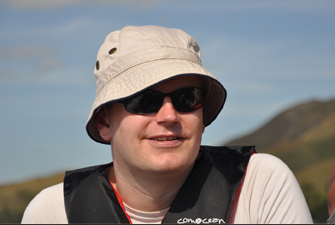ABM Archive Website
THIS WEBSITE CONTAINS ARCHIVE MATERIALS FOR HISTORICAL REFERENCE ONLY
For up-to-date information, including our latest appeals, news, and resources, please visit our current website.
A Pilgrim’s Tale
 |
| Christopher Brooks in Dogura. |
The following is an extract from an account of the 2011 Modawa Pilgrimage to Papua New Guinea written by Christopher Brooks, ABM’s Communications and Fundraising Manager.
For the full story (11 pages), you can download a .pdf copy here.
Friday 12th August
Continuing on our “royal” tour of the Dogura Diocese, Friday was scheduled as a visit to the village of Pova. Pova was a good walk from Wedau so we met at the Diocesan office in the morning in order to meet up with our guide. The discussion of foot wear had reared its head and we’d decided to go in walking boots as it was about 2 hours inland – they had omitted the fact that we had 6 rivers to cross to get there though!
Once we arrived, we were met by the Mother’s of the village with the Welcome song, garlands and a special floral archway for us to enter the village. We were then introduced to the villagers, speeches were made and then lunch commenced. The usual banquet was laid on for us and then we had some time to talk with the villagers – about 4 hours.
Pova was probably the most interesting place that we had visited from a social economic perspective. Everybody was lovely and friendly, made us feel welcome by their hospitality but we got the impression that there were issues here that weren’t present in the villages around the cathedral. This was an extremely poor village with numerous health and education challenges. Having said that, there was an elementary school in the village and we were able to spend some time talking to the teachers and children. They were being taught in their local tongue (Dawawa – which doesn’t have the letters “C” or “K” in it) and also learning English.
After World War II, the government had planned for the North side of the Dogura Diocese to become a tourist hotspot. Money had been spent on educating the people and building infrastructure, such as an air strip. The tourism trade never materialised though and 10 years ago the airstrip had to close. The route into Dogura that we took a few days previously was now the only way, apart from walking, to actually reach the places we were visiting.
Without anywhere for a plane to land, there is no chance of an emergency evacuation if anyone became suddenly ill. If a mother has complications during childbirth, for example, the quickest way to the nearest doctor, is to get to the coast, take a dinghy for anything up to 8 hours and then another 5 hours on a PMV if the weather is bad. That’s 13 hours in bad weather. The quickest it can be done is 5 hours.
Today, if we hadn’t reached the conclusion already, was the day that everybody in the group was touched by how hard life still is for a lot of Papua New Guineans.
Once we had finished all our stories and conversations, it was time to leave. All the villagers made a line and we went down and said goodbye to each and every one of them. For people who have so little to give so much made us feel very poor indeed.
Our walk home wasn’t as upbeat as it had been heading to Pova or on the way home after any of our other visits. Many of us were in thought and prayer about the people we had just met and, if they were anything like me, were feeling extremely helpless. Time for some quiet time when we got back so I took myself off to the stream to wash some clothes and myself.
< Back


